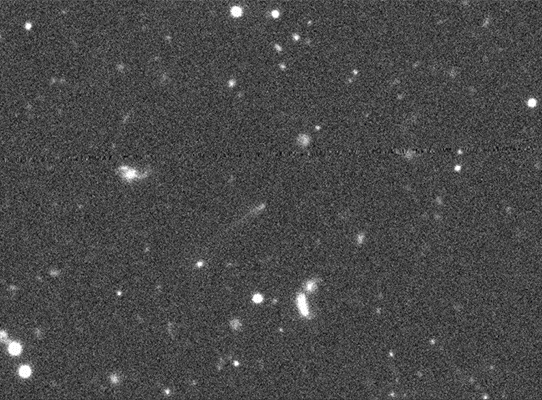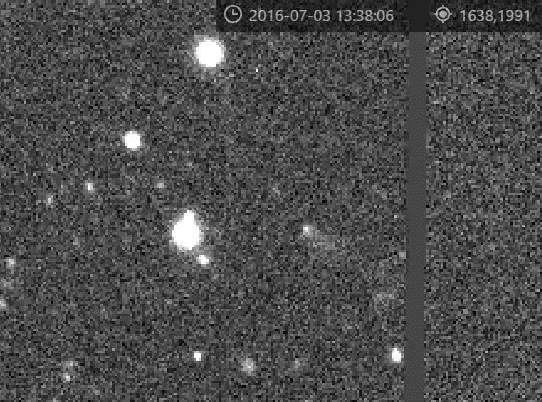COIAS (Come On! Impacting ASteroids) is a web-based application that lets anyone search for Small Solar System Bodies (SSSBs) using images taken by the Subaru Telescope. Since its launch in July 2023, many users have enjoyed exploring these images and searching for previously unrecognized SSSBs. Now, we are excited to share that COIAS has led to its first comet discovery and the official naming of three asteroids.

Figure 1: Comet C/2015 K7 (COIAS), the first comet discovered using COIAS. (Credit: NAOJ / COIAS Development Team)
Over the past 25 years, the Subaru Telescope has contributed to a wide range of scientific discoveries. However, comet discoveries have been limited to just a few cases, and to the best of our knowledge, no asteroids had ever been officially named based on Subaru Telescope data (Note 1). This is likely because discovering comets and asteroids was not among the telescope’s primary scientific objectives. Now, thanks to the COIAS citizen science project, we have accomplished these milestones.
Comet Discovery
On November 26, 2024, Mr. Yamauchi, one of the citizen scientists using COIAS, reported the detection of a cometary object to the COIAS development team. The team conducted a thorough review and confirmed that it appeared to be a previously unknown comet. They consulted Dr. Peter Veres of the IAU Minor Planet Center (MPC) and submitted a report to the MPC's Possible Comet Confirmation Page (PCCP), including the observation date and time, as well as the length and direction of the comet's tail. Once the information was posted on the PCCP, astronomers worldwide begin conducting follow-up observations and searching for the object in archival images from various observatories. Thanks to the efforts of several individuals, including Mr. S. Deen in the United States, the comet was identified in archival data from multiple observatories. As a result, COIAS achieved its first comet discovery.
The most remarkable characteristic of Comet C/2015 K7 (COIAS) is that it exhibited cometary activity (formation of a tail) at a distance of about 10 astronomical units (au) from the Sun (where 1 au is the Earth-Sun distance). At such a distance, sunlight is too weak to cause water ice or carbon dioxide ice (dry ice) to sublimate. It is likely that the tail was formed by the sublimation of carbon monoxide ice instead. Such comets have rarely been seen in past records. With large telescopes like the Subaru Telescope, it may be possible to find more comets that are active far from the Sun.
In March 2025, a second comet was discovered using COIAS. This comet, P/2016 P5 (COIAS), is a rare type of periodic comet that orbits the Sun in an almost circular path at a distance of about 4.7 au — slightly inside the orbit of Jupiter.

Figure 2: P/2016 P5 (COIAS), the second comet discovered with COIAS. (Credit: NAOJ / COIAS Development Team)
Finding and Naming Asteroids

Figure 3: Three asteroids discovered and named via COIAS. From left to right: (697402) Ao, (718492) Quro, and (719612) Hoshizaki. The numbers in parentheses are official asteroid numbers, assigned once an asteroid's orbit is well determined. (Credit: NAOJ / COIAS Development Team)
Going back a bit before the comet discoveries, three asteroids discovered using COIAS in September and November 2024 —(697402), (718492), and (719612)— were officially
named “Ao”, ”Quro”, and “Hoshizaki,” respectively.
To assign a name to an asteroid, it must first receive a provisional number (Note 2), and then undergo extensive follow-up observations and/or precovery over a long period to determine its orbit accurately and receive an asteroid number. In these cases, all three of these asteroids had precovery data from other observatories (Note 3), which significantly extended the observation arcs. As a result, these asteroids were granted official asteroid numbers in a relatively short time after their discovery via COIAS.
Once an asteroid receives its official number, a name can be proposed to the IAU, but the naming rights belong to the original observers. Since COIAS uses data from the Subaru Telescope’s strategic survey program (HSC-SSP), the naming rights formally belong to the HSC-SSP team. However, when the COIAS development team requested permission to propose names, the HSC-SSP team generously agreed.
The three asteroids named this time were all inspired by the anime/manga "Asteroid in Love": "Ao" (after Ao Manaka, one of the main characters), "Quro" (after Quro,
the manga artist of the series), and "Hoshizaki" (after Hoshizaki High School, the setting of the story—also the name given by the characters in the series to a discovered asteroid). The naming proposals were decided through discussions between the citizen scientists who measured and reported the asteroids and the COIAS development team.
When preparing the naming proposals, we were aware that in the past, it was relatively common for asteroids to be named after anime characters or manga artists. However, in recent years, we had heard that the IAU’s Working Group for Small Body Nomenclature has become more strict, requiring well-justified reasons for such names to be approved. To support our proposals, we carefully explained how "Asteroid in Love" has contributed to public outreach and education in astronomy and planetary science. As a result, the proposed names were successfully accepted.
COIAS has discovered over 5,000 objects with provisional designations that have not yet been assigned official asteroid numbers. We expect that many of these objects will receive official numbering thanks to follow-up observations by other observatories, as well as the publication of HSC-SSP Data Release 4. For future naming opportunities, we look forward to working together with citizen scientists to come up with names in a fun and collaborative way.
In fact, while this article was being written, a fourth COIAS-discovered asteroid received its official number: (788153). One of the most exciting aspects of the COIAS project is how quickly things can change as new discoveries unfold. Please stay tuned for more developments!
Seitaro Urakawa (Japan Spaceguard Association)
(Note 1) Among SSSBs, those with visible tails are called comets, while those without tails are called asteroids. Objects located beyond Neptune are classified as trans-Neptunian objects (TNOs) and are considered different from asteroids. While names can be proposed for asteroids, this is not the case for comets. Instead, comet names are assigned according to specific rules, usually based on the discoverer’s name or the name of the project. However, not all comets are given names.
(Note 2) When a newly discovered small Solar System body is observed over multiple nights, a provisional designation is assigned by the Minor Planet Center (MPC) of the IAU.
(Note 3) The observational data obtained by other observatories in the past were limited to a single night. If the data had spanned two or more nights, however, the discovery credit would have been attributed to that observatory.


